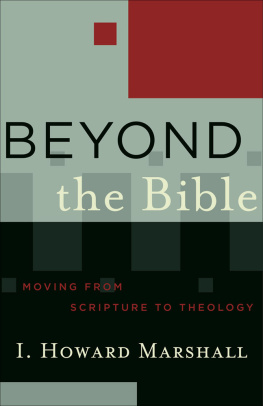Edith M. Humphrey - Scripture and Tradition: What the Bible Really Says
Here you can read online Edith M. Humphrey - Scripture and Tradition: What the Bible Really Says full text of the book (entire story) in english for free. Download pdf and epub, get meaning, cover and reviews about this ebook. year: 2013, publisher: Baker Publishing Group, genre: Religion. Description of the work, (preface) as well as reviews are available. Best literature library LitArk.com created for fans of good reading and offers a wide selection of genres:
Romance novel
Science fiction
Adventure
Detective
Science
History
Home and family
Prose
Art
Politics
Computer
Non-fiction
Religion
Business
Children
Humor
Choose a favorite category and find really read worthwhile books. Enjoy immersion in the world of imagination, feel the emotions of the characters or learn something new for yourself, make an fascinating discovery.
- Book:Scripture and Tradition: What the Bible Really Says
- Author:
- Publisher:Baker Publishing Group
- Genre:
- Year:2013
- Rating:5 / 5
- Favourites:Add to favourites
- Your mark:
- 100
- 1
- 2
- 3
- 4
- 5
Scripture and Tradition: What the Bible Really Says: summary, description and annotation
We offer to read an annotation, description, summary or preface (depends on what the author of the book "Scripture and Tradition: What the Bible Really Says" wrote himself). If you haven't found the necessary information about the book — write in the comments, we will try to find it.
Scripture and Tradition: What the Bible Really Says — read online for free the complete book (whole text) full work
Below is the text of the book, divided by pages. System saving the place of the last page read, allows you to conveniently read the book "Scripture and Tradition: What the Bible Really Says" online for free, without having to search again every time where you left off. Put a bookmark, and you can go to the page where you finished reading at any time.
Font size:
Interval:
Bookmark:
Acadia Studies in Bible and Theology
Craig A. Evans and Lee Martin McDonald, Series Editors
T he last two decades have witnessed dramatic developments in biblical and theological study. Full-time academics can scarcely keep up with fresh discoveries, recently published primary texts, ongoing archaeological work, new exegetical proposals, experiments in methods and hermeneutics, and innovative theological syntheses. For students and nonspecialists these developments are confusing and daunting. What has been needed is a series of succinct studies that assess these issues and present their findings in a way that students, pastors, laity, and nonspecialists will find accessible and rewarding. Acadia Studies in Bible and Theology, sponsored by Acadia Divinity College in Wolfville, Nova Scotia, and in conjunction with the colleges Hayward Lectureship, constitutes such a series.
The Hayward Lectureship has brought to Acadia many distinguished scholars of Bible and theology, such as Sir Robin Barbour, John Bright, Leander Keck, Helmut Koester, Richard Longenecker, Martin Marty, Jaroslav Pelikan, Ian Rennie, James Sanders, and Eduard Schweizer. Acadia Studies in Bible and Theology reflect this rich heritage.
These studies are designed to guide readers through the ever more complicated maze of critical, interpretative, and theological discussion taking place today. But these studies are not introductory in nature; nor are they mere surveys. Written by leading authorities in the field, Acadia Studies in Bible and Theology offer critical assessments of the major issues that the church faces in the twenty-first century. Readers will gain the requisite orientation and fresh understanding of the important issues that will enable them to take part meaningfully in discussion and debate.
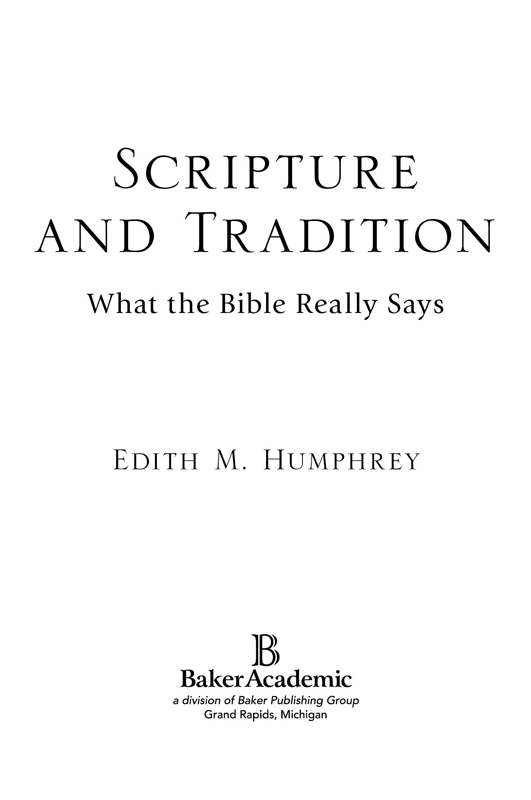
2013 by Edith M. Humphrey
Published by Baker Academic
a division of Baker Publishing Group
P.O. Box 6287, Grand Rapids, MI 49516-6287
www.bakeracademic.com
Ebook edition created 2013
All rights reserved. No part of this publication may be reproduced, stored in a retrieval system, or transmitted in any form or by any meansfor example, electronic, photocopy, recordingwithout the prior written permission of the publisher. The only exception is brief quotations in printed reviews.
Library of Congress Cataloging-in-Publication Data is on file at the Library of Congress, Washington, DC.
ISBN 978-1-4412-4048-4
Unless otherwise indicated, Scripture quotations are from the Revised Standard Version of the Bible, copyright 1952 [2nd edition, 1971] by the Division of Christian Education of the National Council of the Churches of Christ in the United States of America. Used by permission. All rights reserved.
Scripture quotations labeled EH are the authors translation.
Scripture quotations labeled ESV are from The Holy Bible, English Standard Version (ESV), copyright 2001 by Crossway, a publishing ministry of Good News Publishers. Used by permission. All rights reserved. ESV Text Edition: 2007
Scripture quotations labeled KJV are from the King James Version of the Bible.
Scripture quotations labeled NIV are from the Holy Bible, New International Version. NIV. Copyright 1973, 1978, 1984, 2011 by Biblica, Inc. Used by permission of Zondervan. All rights reserved worldwide. www.zondervan.com
Scripture quotations labeled NLT are from the Holy Bible , New Living Translation, copyright 1996, 2004, 2007 by Tyndale House Foundation. Used by permission of Tyndale House Publishers, Inc., Carol Stream, Illinois 60188. All rights reserved.
Scripture quotations labeled NRSV are from the New Revised Standard Version of the Bible, copyright 1989, by the Division of Christian Education of the National Council of the Churches of Christ in the United States of America. Used by permission. All rights reserved.
The internet addresses, email addresses, and phone numbers in this book are accurate at the time of publication. They are provided as a resource. Baker Publishing Group does not endorse them or vouch for their content or permanence.
Cover
Series Page
Title Page
Copyright Page
Dedication
Preface
Introduction
1. Lost in Translation?
2. Deadly Traditions: The Bible, the Rabbis, Jesus, and St. Paul
3. The Apostles, the Word, and the Letter
4. The Blessed Delivery: Receiving in Both Directions
5. Tradition as Gods Personal Gift
6. Holy Tradition versus Human Traditions: Discerning the Difference Today
Conclusion
Notes
Bibliography
Subject Index
Scripture Index
Cover
As I come to the conclusion of writing this book, I find myself enormously grateful for the many who have helped me, and continue to help me, to see the vibrancy of what has been given to the Church. What do you have except that which you have received? (1 Cor. 4:7 EH). In the context of this project, I especially am grateful for my husband Chris, who first challenged me to analyze what the Bible says about traditionand whom I ignored until I had an inexplicably sleepless night when the question came back to haunt me. Thanks are also due to the kind invitation of Prof. Craig Evans, who hosted me when I delivered the Hayward Lectures at Acadia University in the fall of 2010, as well as for the forbearance and searching questions of those who attended these initial presentations, which formed the nucleus of this book. It is necessary also to mention the thought-provoking discussion that took place in the PCUSA Wee Kirk Conference near Pittsburgh, where I tried out these ideas in October 2010, and the keen interest of students who worked with me during my spring 2011 class on Scripture and Tradition at Pittsburgh Theological Seminary. For several years, too, I have been spurred on by conversations on this and related topics with three more-advanced students who have been discussion partners with me since their graduation from PTSMatthew Bell, Timothy Becker, and Lisa Rene Sayre.
During the process of transformation from presentations to book, I have found invaluable the illuminating comments and gracious suggestions of the Rev. Dr. John Breck, whose own work on Scripture and Tradition has been instructive to me (as to many others). I hope that my volume will be accessible to the nonspecialist who is interested in traditionand this is a pressing concern to many in the Churchwithout boring those for whom the topic is not new. My assistant, Kathy Anderson, read all of this manuscript and was invaluable in clarifying the prose and cleaning it up prior to its submissionno, Virginia, there were no ancient manuscripts found in the Dead Sea! Further infelicitous details were discovered and suggestions made by Alan J. Kirk, my meticulous colleague in New Testament; Fr. Sean Taylor, my doughty comrade; and Bessie F. McEwan, my ever-perceptive mother. Thanks also for the labor of friends at Baker Academic, who partner with Acadia University in this series, and have done further necessary work to bring all this to fruition. As January draws to a close, I anticipate the Feast of the Presentation (Visitation) at the Temple, and recall the wonder I experienced three years ago when I first clearly envisioned holy Mary as the one who presented herself to the Lord, and who offers the living Word to us, as she did to Symeon: Christ the coal of fire, whom holy Isaiah foresaw, now rests in the arms of the Theotokos as in a pair of tongs, and He is given to the elder (Small Vespers); Mary, you are the mystic Tongs, who has conceived in your womb Christ the live Coal (Matins, Canticle 9).
Font size:
Interval:
Bookmark:
Similar books «Scripture and Tradition: What the Bible Really Says»
Look at similar books to Scripture and Tradition: What the Bible Really Says. We have selected literature similar in name and meaning in the hope of providing readers with more options to find new, interesting, not yet read works.
Discussion, reviews of the book Scripture and Tradition: What the Bible Really Says and just readers' own opinions. Leave your comments, write what you think about the work, its meaning or the main characters. Specify what exactly you liked and what you didn't like, and why you think so.


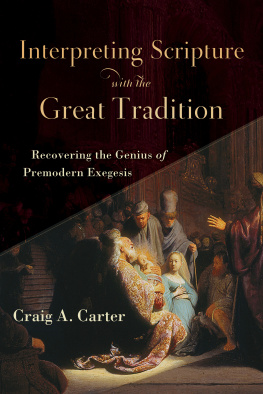
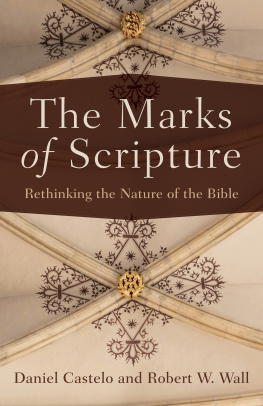
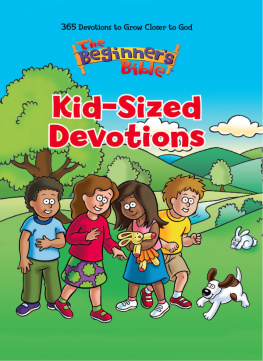


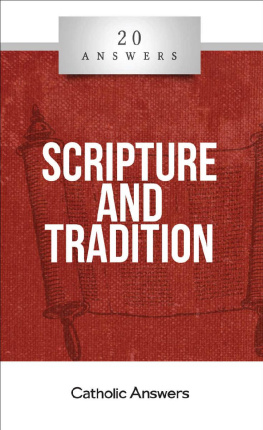
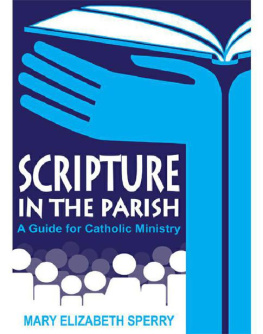

![Scott Hahn [Inconnu(e)] - Scripture Matters: Essays on Reading the Bible From the Heart of the Church](/uploads/posts/book/134760/thumbs/scott-hahn-inconnu-e-scripture-matters-essays.jpg)
